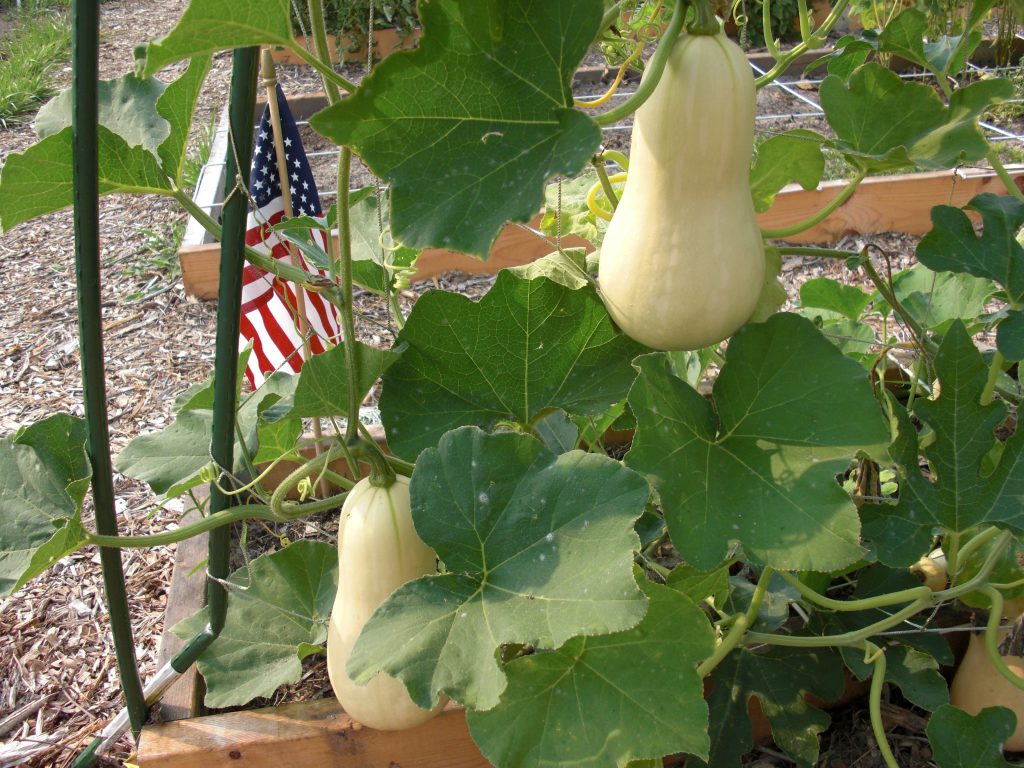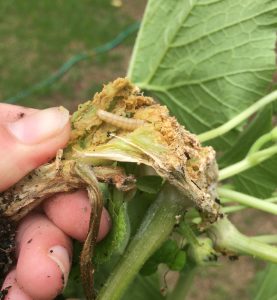
Butternut squash is more resistant to squash vine borers and it has a vining growth habit, perfect for growing on a trellis. Photo by Janis Piotrowski.
Last spring, I fought the good fight against a very pesky garden pest. As the pandemic ramped up, I started working remotely from home, which I figured would at least afford me the ability to scout my patch of summer squash a bit more diligently.
I was able to successfully remove a few tiny eggs that had been deposited individually on the base of the squash’s elongating bright green stems. And, since I planted early in the season, I was able to harvest a few beautiful looking – and very delicious tasting – summer squash for the dinner table. But alas, most of my hard work succumbed to my biggest garden foe: Melittia cucurbitae. Aka, the squash vine borer.

Squash vine borer larvae can most easily navigate the stems of summer squash varieties. Photo by Molly Jameson.
This year, I am trying a new approach. Instead of marching through my garden morning and night swatting wildly at borer moths – or repeatedly coating Baccillus thuringiensis biological insecticide spray over the squash stems every week – I am switching it up. This year, it is all about Cucurbita moschata. Aka, butternut squash.
How can this cucurbit avoid the mighty squash vine borer, you ask? Well typically, after hatching, squash vine borer larvae will quickly chew into the succulent stem of a summer squash variety. These large, hollow stems then act as an open highway for the borers, and they easily work their way up. The stems of butternut squash, on the other hand, are less palatable for the larvae. Their vining habit produces stems that are harder to navigate, thicker, and tougher than summer squash stems. Although not completely resistant, they are certainly not the borers’ preferred host plant.
And thankfully, butternut squash is quite delicious. It can be roasted to accompany just about anything, including spaghetti, lasagna, salads, chilis, and stews. It can also be blended into soups or purees to be paired with herbs and spices, such as turmeric, sage, garlic, and thyme. Or, it can be used as a filling in pies or frittatas, brushed with brown butter to sweeten up the plate as a delicious side dish, or be paired with goat cheese and crackers to be served as an appetizer.
Sometimes, simply omitting your toughest garden foe’s favorite host plant is the best path to both garden and dinner plate success.
- The Dirt on Compost: Hot and Worm Composting at Home - October 30, 2025
- Fall Gardening Spotlight: Collard Greens - October 3, 2025
- Dung Beetles of the Florida Panhandle - June 26, 2025
